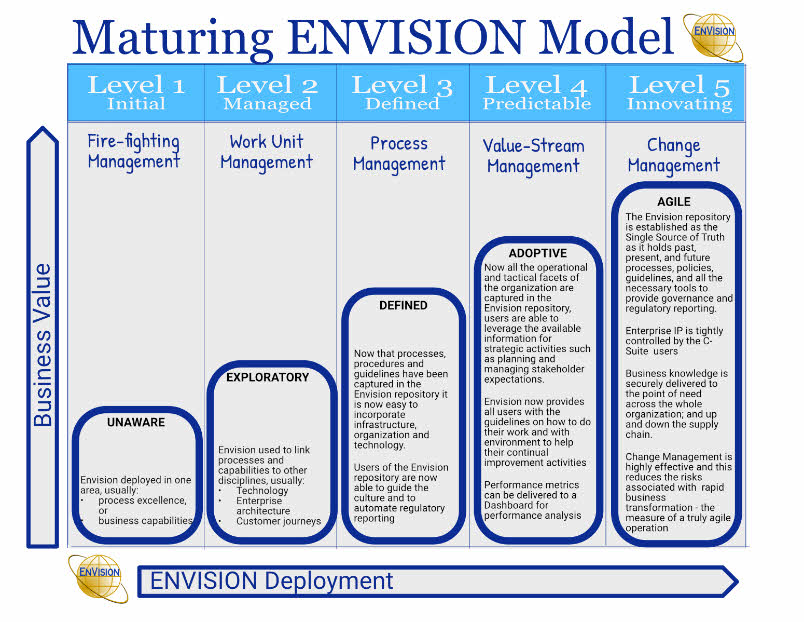|

Organizations under-estimate the need for maturity
|

Organizations over-estimate the value of agility without maturity
|

Constantly rethink, reinvigorate, react, and reinvent.
|

Only those who have the agility to change with the market and innovate quickly will survive
|
| There are obstacles on the road to agility |
|
• Our Information is too difficult to manage
• We have silos of information
• Our security has gaps
|
• Our processes are stable but running in isolation
• The tools we have are frustrating and complex
• The most talented people in our organization are stretched beyond their capacity
|
The Road to Maturity
Organizations have been mapping business processes for decades and the effort has led to improvement in the way the organization operates. But this work on its own does not characterize an operation fit for the 21st century. Processes rely on other domains, and unless you can link processes, capabilities, and resources altogether into what we call “a single source of truth” it is impossible to be truly dynamic and create market led value streams. The nightmare of agile change management is characterized by causing problems in one area by making improvements in another. An organization encompasses many differing perspectives:

The Business Process Maturity Model (BPMM) from OMG has been around since 2008. The aim is to improve organizational readiness for rapid and continual change (agility). Our team has interpreted the model as a way to connect the dots and align people, processes, and technology with the value stream. Our team delivers Envision, a business object repository, that creates an environment to deliver business maturity along these lines:
 People
People
- skills are mature and consistent across capabilities
- knowledge sharing is in place and there is a culture of improvement
- leadership visibly drives value, growth, and innovation
Process
- processes are continuously monitored and improved
- process plans and strategies are reviewed against changes in the value stream requirements
Technology
- the use of new technologies is commonplace
- tools and technology are regularly reviewed to ensure that they are in line with value stream requirements
Use one Business Object Store
All organizations are a blend of structure (architecture or organization), capabilities, and technology. Running through the organization should be the value stream (or raison d’être). Using a business object approach ensures that capability and process maps linked to a representation of the technology portfolio contain a complete business-centric view of the business without duplication.
 Envision is usually first applied at the point of most pain. This is commonly process improvement. Once the first step is established it is easy to extend the models and diagrams to document the technology portfolio and business capabilities and link them to the business strategy.
Envision is usually first applied at the point of most pain. This is commonly process improvement. Once the first step is established it is easy to extend the models and diagrams to document the technology portfolio and business capabilities and link them to the business strategy.
Almost by default, a top-down enterprise architecture view and a bottom-up value-stream vision are created. The diagrams link with company & market data to become essential tools in optimizing the organization and reporting on activity.
Reports & Dashboard
 The very act of creating a single business object repository creates a Business Intelligence platform. A good dashboard enables you to monitor and measure performance and metrics in near real-time. You can see the Key Performance Indicators (KPIs) across the whole organization in one visualization. This provides valuable insights and supports accurate decision-making. A business object repository can manage big data with a value-stream perspective. This focus is very valuable to managers.
The very act of creating a single business object repository creates a Business Intelligence platform. A good dashboard enables you to monitor and measure performance and metrics in near real-time. You can see the Key Performance Indicators (KPIs) across the whole organization in one visualization. This provides valuable insights and supports accurate decision-making. A business object repository can manage big data with a value-stream perspective. This focus is very valuable to managers.
- Reports that pull information from process and capability objects can create operations manuals that deliver information to the point of need across the whole organization.
- In addition, a business object repository linked to data provides the perfect environment to automate Regulatory Reporting and substantially reduces the level of effort of production, audit, delivery, and assessment.
To see a single business object repository at work
Click Here
Now you have Maturity and Agility
An agile organization is characterized by having a comprehensive portfolio of optimized business process and business capability maps grouped by their role in value creation for the customers and support of the business strategy. These maps are linked to all the other disciplines such as finance, governance, resource management, talent management, and customer experience. Thus, Corporate IP can be securely delivered to the point of need. A mature and agile organization can be recognized by:
1. Everyone in the organization understands the business strategy and tactics
2. Everyone understands the need for agility and are motivated to participate in change
3. Organizational plans are understood, and everyone knows their personal and departmental goals
4. Business processes have been optimized and there is process model governance
5. The technology portfolio is aligned with the business strategy
6. There is business capability alignment
Author: Rob Allen, Lead SME, Future Tech Systems, Inc
BS in Chemistry, Masters in IT, Fellow of UK Business Risk Round Table, Rob has worked in the USA and Europe for over 40 years in corporate governance of digital operations. He has a track record of successfully enhancing complex and regulated businesses through his business process optimization skills.
Future Tech Systems Inc, 21618 Quiet Water Loop, Lake Tapps, WA 98391 www.future-tech.com